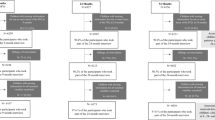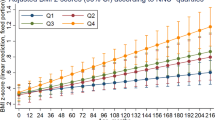Abstract
Objective:
To assess whether patterns of dietary exposures at 9 months are associated with child diet and weight at 6 years.
Methods:
Data for this study were from the Infant Feeding Practices Study II and Year 6 Follow-Up Studies. All data were self-reported monthly. Results of a previous latent class analysis revealed five dietary patterns varying in milk and solid food intake. These five infant dietary patterns were used in the current study to predict child diet and weight outcomes at 6 years, while controlling for confounding variables.
Results:
Infants with dietary patterns higher in fruit and vegetable intake at 9 months had higher fruit and vegetable intake at 6 years. Similarly, infants with the dietary pattern characterized by foods high in energy density (that is, French Fries and sweet desserts) continued to have higher consumption of these foods at 6 years, and had a higher prevalence of overweight at 6 years (43%) compared with the other classes. Formula-fed infants had higher sugar-sweetened beverage intake and fewer met the dietary guidelines for fruit and vegetable intake at 6 years than breastfed infants, controlling for factors such as income.
Conclusions:
Early decisions about milk-feeding, and the types of solid foods offered in infancy can foreshadow dietary patterns and obesity risk later in childhood. Infants who were offered energy-dense foods had higher intake of these foods at 6 years of age.
This is a preview of subscription content, access via your institution
Access options
Subscribe to this journal
Receive 12 print issues and online access
$259.00 per year
only $21.58 per issue
Buy this article
- Purchase on Springer Link
- Instant access to full article PDF
Prices may be subject to local taxes which are calculated during checkout
Similar content being viewed by others
References
Mennella JA, Jagnow CP, Beauchamp GK . Prenatal and postnatal flavor learning by human infants. Pediatrics 2001; 107: E88.
Perrine CG, Galuska DA, Thompson FE, Scanlon KS . Breastfeeding duration is associated with child diet at 6 years. Pediatrics 2014; 134: S50–S55.
Saavedra JM, Deming D, Dattilo A, Reidy K . Lessons from the feeding infants and toddlers study in North America: what children eat, and implications for obesity prevention. Ann Nutr Metab 2013; 62: 27–36.
Grimm KA, Kim SA, Yaroch AL, Scanlon KS . Fruit and vegetable intake during infancy and early childhood. Pediatrics 2014; 134: S63–S69.
Park S, Pan L, Sherry B, Li R . The association of sugar-sweetened beverage intake during infancy with sugar-sweetened beverage intake at 6 years of age. Pediatrics 2014; 134: S56–S62.
Pan L, Li R, Park S, Galuska DA, Sherry B, Freedman DS . A longitudinal analysis of sugar-sweetened beverage intake in infancy and obesity at 6 Years. Pediatrics 2014; 134: S29–S35.
Fein SB, Labiner-Wolfe J, Shealy KR, Li R, Chen J, Grummer-Strawn LM . Infant feeding practices study II: Study methods. Pediatrics 2008; 122: S28–S35.
Rose CM, Savage JS, Birch LL . Patterns of early dietary exposures have implications for maternal and child weight outcomes. Obesity 2015; 24: 430–438.
Lanza ST, Collins LM, Lemmon DR, Schafer JL, PROC LCA . A SAS procedure for latent class analysis. Struct Equ Modeling 2007; 14: 671–694.
Fein SB, Li R, Chen J, Scanlon KS, Grummer-Strawn LM . Methods for the year 6 follow-up study of children in the Infant Feeding Practices Study II. Pediatrics 2014; 134: S4–S12.
Briefel RR, Reidy K, Karwe V, Jankowski L, Hendricks K . Toddlers’ transition to table foods: Impact on nutrient intakes and food patterns. J Am Diet Assoc 2004; 104: 38–44.
Devaney B, Ziegler P, Pac S, Karwe V, Barr SI . Nutrient intakes of infants and toddlers. J Am Diet Assoc 2004; 104: 14–21.
Committee DGA. Report of the Dietary Guidelines Advisory Committee on the Dietary Guidelines for Americans, 2010, to the Secretary of Agriculture and the Secretary of Health and Human Services. Agricultural Research Service 2010. Available at http://www.nutriwatch.org/05Guidelines/dga_advisory_2010.pdf.
Kuczmarski RJ, Ogden CL, Guo SS, Grummer-Strawn LM, Flegal KM, Mei Z et al. 2000 CDC Growth Charts for the United States: methods and development. Vital Health Stat 11 2002; 246: 1–190.
Kiefte-de Jong JC, de Vries JH, Bleeker SE, Jaddoe VW, Hofman A, Raat H et al. Socio-demographic and lifestyle determinants of ‘Western-like’and ‘Health conscious’ dietary patterns in toddlers. Br J Nutr 2013; 109: 137–147.
Northstone K, Emmett P, Nethersole F . The effect of age of introduction to lumpy solids on foods eaten and reported feeding difficulties at 6 and 15 months. J Hum Nutr Diet 2001; 14: 43–54.
Scott JA, Binns CW, Graham KI, Oddy WH . Predictors of the early introduction of solid foods in infants: results of a cohort study. BMC Pediatr 2009; 9: 60.
Haycraft E, Farrow C, Blissett J . Maternal symptoms of depression are related to observations of controlling feeding practices in mothers of young children. J Fam Psychol 2013; 27: 159.
Yu Z, Han S, Zhu J, Sun X, Ji C, Guo X . Pre-pregnancy body mass index in relation to infant birth weight and offspring overweight/obesity: a systematic review and meta-analysis. Plos One 2013; 8: e61627.
Bray B, Lanza ST, Tan X . An Introduction to Elminating Bias in Classify-Analyze Approaches for Latent Class Analysis. The Methodology Center at Penn State: University Park, PA, USA, 2012.
Rose CM, Savage JS, Birch LL . Predictors of early dietary exposure patterns and consequences for maternal and infant weight outcomes. Obesity 2015; 24: 430–438.
Vernarelli JA, Mitchell DC, Hartman TJ, Rolls BJ . Dietary energy density is associated with body weight status and vegetable intake in US children. J Nutr 2011; 141: 2204–2210.
Jones-Smith JC, Dieckmann MG, Gottlieb L, Chow J, Fernald LC . Socioeconomic status and trajectory of overweight from birth to mid-childhood: the Early Childhood Longitudinal Study-Birth Cohort. Plos One 2014; 9: e100181.
Uauy R, Peirano P . Breast is best: human milk is the optimal food for brain development. Am J Clin Nutr 1999; 70: 433–434.
McConley RL, Mrug S, Gilliland MJ, Lowry R, Elliott MN, Schuster MA et al. Mediators of maternal depression and family structure on child BMI: parenting quality and risk factors for child overweight. Obesity 2011; 19: 345–352.
Wardle J, Cooke L . Genetic and environmental determinants of children's food preferences. Br J Nutr 2008; 99: S15–S21.
Caton SJ, Ahern SM, Remy E, Nicklaus S, Blundell P, Hetherington MM . Repetition counts: repeated exposure increases intake of a novel vegetable in UK pre-school children compared to flavour–flavour and flavour–nutrient learning. Br J Nutr 2013; 109: 2089–2097.
Birch LL, Anzman SL . Learning to eat in an obesogenic environment: a developmental systems perspective on childhood obesity. Child Dev Perspect 2010; 4: 138–143.
Acknowledgements
The manuscript work was funded by the USDA National Institute for Food and Agriculture Grant #2011-67001-30117 Program A2121—Childhood Obesity Prevention: Transdisciplinary Graduate Education and Training in Nutrition and Family Sciences.
Author information
Authors and Affiliations
Corresponding author
Ethics declarations
Competing interests
The authors declare no conflict of interest.
Rights and permissions
About this article
Cite this article
Rose, C., Birch, L. & Savage, J. Dietary patterns in infancy are associated with child diet and weight outcomes at 6 years. Int J Obes 41, 783–788 (2017). https://doi.org/10.1038/ijo.2017.27
Received:
Revised:
Accepted:
Published:
Issue Date:
DOI: https://doi.org/10.1038/ijo.2017.27
This article is cited by
-
Adiposity and feeding practices in the first two years of life among toddlers in Guadalajara, Mexico
BMC Pediatrics (2023)
-
Weight development between age 5 and 10 years and its associations with dietary patterns at age 5 in the ABCD cohort
BMC Public Health (2020)
-
Preserving Cardiovascular Health in Young Children: Beginning Healthier by Starting Earlier
Current Atherosclerosis Reports (2018)



